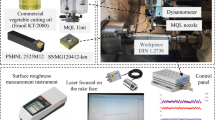Abstract
High-pressure coolant (HPC) delivery is an emerging technology that delivers a high-pressure fluid to the tool and workpiece in machining processes. High fluid pressure allows for better penetration of the fluid into the cutting zone, enhancing the cooling effect, and decreasing tool wear through lubrication of the contact areas. The main objective of this work is to understand how tool wear mechanisms are influenced by fluid pressure under different cutting speeds in the finish turning of AISI 1045 steel using coated carbide tools. The main finding was that the use of a lower cutting speed (v c = 490 m/min) in dry cutting resulted in tool life close to that obtained with cutting fluid, but when the cutting speed was increased (v c = 570 m/min), the high-pressure coolant was effective in prolonging the life of the cutting tool. It was also concluded that, regardless of the cutting speed and cooling/lubrication system, the wear mechanisms were the same, namely abrasion and attrition.
Similar content being viewed by others
References
Sandvik Coromant (1994) Modern metal cutting, 1st edn. Sandvik Coromant Technical Editorial Department, Tofters Tryckeri, Sweden
Trent EM (1991) Metal cutting. Butterworths-Heinemann, Oxford
Usui E, Shirakashi T, Kitagawa T (1978) Analytical prediction of three-dimensional cutting process. Trans ASME 100:236–243
Trigger KJ, Chao T (1951) Cutting temperatures and metal-cutting phenomena. Trans ASME 777-793
Wong T, Kim W, Kwon P (2004) Experimental support for a model-based prediction of tool wear. WEAR 257:790–798. doi:10.1016/j.wear.2004.03.010
Diniz AE, Marcondes FC, Coppini NL (2006) Tecnologia da usinagem dos materiais. Artliber Editora, São Paulo (in Portuguese)
Machado AR, Silva MB (2003) Usinagem dos metais. Editora da UFU, Uberlândia (in Portuguese)
Mari D, Gonseth DR (1993) A new look at carbide tool life. WEAR 165:9–17. doi:10.1016/0043-1648(93)90366-T
Diniz AE, Micaroni R (2002) Cutting conditions for finish turning process aiming the use of dry cutting. Int J Mach Tools Manuf 42:899–904. doi:10.1016/S0890-6955(02)00028-7
Diniz AE, Oliveira AJ (2004) Optimizing the use of dry cutting in rough turning steel operations. Int J Mach Tools Manuf 44:1061–1067. doi:10.1016/j.ijmachtools.2004.03.001
Pigott RJS, Colwell AT (1952) Hi-jet system for increasing tool life. SAE Quarterly Trans 6(2):547–558
Kaminski J, Alvelid B (2000) Temperature reduction in the cutting zone in water jet-assisted turning. J Mater Proc Tech 106:68–73. doi:10.1016/S0924-0136(00)00640-3
Machado AR, Wallbank J (1994) The effects of a high pressure coolant jet on machining. Proc Inst Mech Eng Part B: J Eng Manuf 208:29–38
Oliveira A J (2003) The optimization of cutting parameters aiming the dry turning of AISI 1045 steel in rough operations. Master Thesis (in Portuguese)
Author information
Authors and Affiliations
Corresponding author
Rights and permissions
About this article
Cite this article
Diniz, A.E., Micaroni, R. & Hassui, A. Evaluating the effect of coolant pressure and flow rate on tool wear and tool life in the steel turning operation. Int J Adv Manuf Technol 50, 1125–1133 (2010). https://doi.org/10.1007/s00170-010-2570-1
Received:
Accepted:
Published:
Issue Date:
DOI: https://doi.org/10.1007/s00170-010-2570-1




